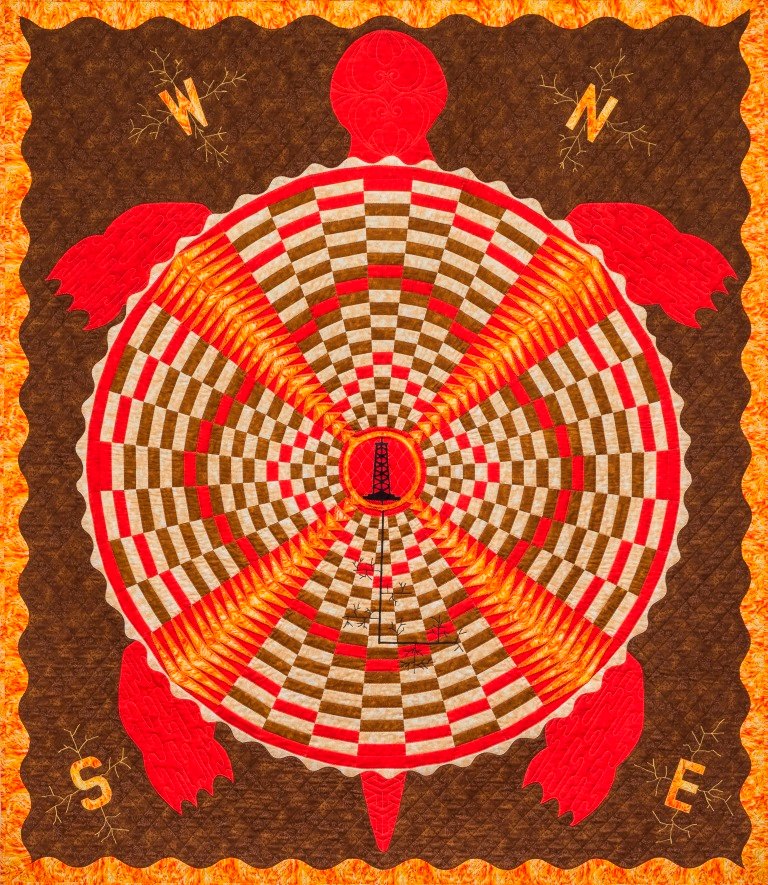Northern Arizona University professor and art historian Jennifer McLerran recently published findings that reveal the rich, complex expression hidden in the work of Native American artist Carla Hemlock and how these messages represent the feminist ethic evident more broadly in the work of indigenous female artists.
The article, published in the peer-reviewed journal Feminist Studies, focuses on the quilts created by Hemlock, a contemporary artist whose work addresses issues such as environmental justice, violence against Native women, treaty rights and tribal sovereignty.
“Mohawk fiber artist Carla Hemlock uses medium and subject matter to upset viewers’ expectations and engage them in critical discourse regarding Native North American women’s histories and contemporary lives,” McLerran said. “Hemlock’s quilts may be seen as simple bed coverings bearing innocuous representations of animals and plants, or they may be read as political statements regarding environmental justice, tribal sovereignty and the ways in which settler colonialism has promulgated violence against indigenous women.”
Native girls learned the art of quilting in 19th-century mission schools and convents. As their artistry evolved, indigenous artists developed a system of double coding, producing imagery that seems benign and innocuous to non-Native viewers but conveys potent cultural and political messages to other Native Americans. The technique preserves Native imagery, histories and stories that may not otherwise have survived colonization, fostering a sense of shared identity among indigenous peoples.
Hemlock’s work, which has won many awards, is housed in the collections of major museums such as the Smithsonian Institution’s National Museum of the American Indian. McLerran believes there are many ways Hemlock’s artistic expression reveals a feminist ethic. “Turtle Island Unravelling,” one of Hemlock’s quilts, uses turtle imagery, female mythological figures, Native cosmology and the image of an oil derrick to address the environmental issues posed by the oil and gas industry through the practice of hydraulic fracturing, or fracking.
Turtle Island is the name given to North America by many indigenous peoples.
“Hemlock questions the wisdom of practices such as fracking, reminding her viewers that humans bear the responsibility to be the earth’s caretakers,” McLerran said. “She superimposes a web across the cosmic turtle’s back to remind us of the fragile web of life that humans in general, and Iroquois women in particular, are entrusted with protecting.”
Other pieces of Hemlock’s art address issues such as gender discrimination and violence toward women.
“She addresses these issues from the vantage point of a contemporary Native person who feels a responsibility to work for the benefit of all members of her community, but also as a Native woman who, by virtue of her own gendered experience and values, perceives the necessity of addressing gender-based discrimination and sexual violence,” McLerran said.
Hemlock uses a variety of fabrics and decorative materials to construct her quilts. Each one is an important element of her expression, symbolizing aspects of her peoples’ history and culture. For example, muslin fabric represents the “treaty cloth” that is distributed annually to the Seneca and Tuscarora tribes by the U.S. Department of the Interior in commemoration of the 1794 Canandaigua Treaty. Wampum, traditional beads made of clam and whelk shells, signify the original wampum belts that were created to bind the tribes to the treaty. She also uses silk ribbons reminiscent of those received in trade by early Mohawks from non-Native settlers.
McLerran, who joined NAU in 2007, specializes in the study of 20th-century Native American art, museum studies and feminist theory. She formerly served as curator of the Kennedy Museum of Art’s Edwin L. and Ruth E. Kennedy Southwest Native American Collection at Ohio University, where she conducted extensive research and curated exhibitions on Navajo weaving and Navajo, Hopi and Zuni silverwork and jewelry traditions. McLerran also served as a Native American Graves Protection and Repatriation Act (NAGPRA) consultant to Yellowstone National Park and the Kennedy Museum of Art, successfully repatriating sacred and ceremonial objects of the Navajo, Hopi and Zuni tribes. She is the author of several books and many scholarly articles.



